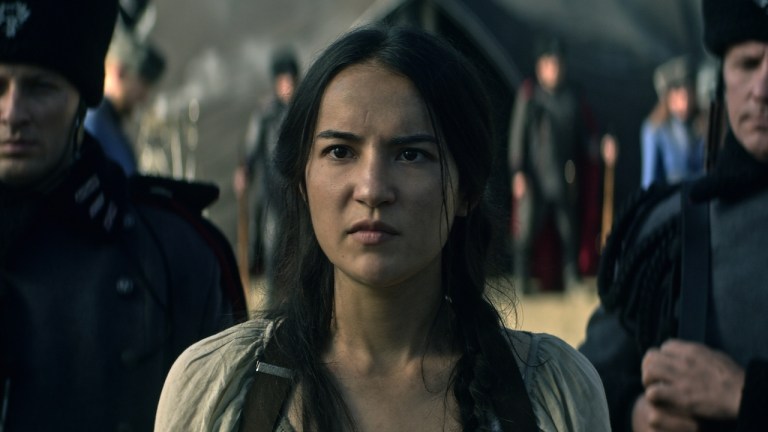Shadow and Bone’s Alina is What a Modern Feminist Fantasy Heroine Looks Like
In Alina, Shadow and Bone gives us a heroine who embraces her power without sacrificing any of her heart.

This Shadow and Bone article contains some spoilers.
Young adult fantasy fiction is one of the most popular literary genres on shelves today, full of a seemingly endless variety of stories about faeries, demons, and the sort of complex magical systems that occasionally need a flow chart to explain. It’s also full of young women, both as central characters and primary readers, all struggling and striving to figure out who they are and how they might find their own magic in the world around them.
Yet there’s a certain kind of genre fan that loves to disparage these kinds of female-focused stories, dismissing them as somehow unserious or otherwise lesser simply because they tend to include heaping doses of romance alongside various other high fantasy elements. For these snootiest of fantasy enthusiasts, the inclusion of things like love triangles and emotional complexity are simply facets of less compelling women’s stories, with no business in this space.
But Netflix’s new series Shadow and Bone understands from its first frames that one doesn’t have to sacrifice one for the other, that it’s okay – perhaps even necessary – to ground its high fantasy storytelling in the very real emotional stakes of young adulthood, from falling in love to figuring out the person you want to become. And, in doing so, it gives us one of the most three-dimensional, satisfying young female leads in years, a heroine who ultimately embraces her power without sacrificing any of her heart.
Based on the bestselling series of Grishaverse novels by Leigh Bardugo, the world of Shadow and Bone is rich and interconnected, spanning multiple continents and encompassing a wide swath of characters, from soldiers and criminals to elite magic users known as Grisha, who can manipulate matter and control specific elements. And at its center is a girl named Alina Starkov, an orphan who’s never quite felt she belonged anywhere, thanks to her lack of family and mixed-race heritage. That feeling of isolation is compounded when she discovers she herself is not just Grisha but a legendary Sun Summoner, possessing a gift so rare that many people believed it didn’t actually exist.
In its simplest terms, the story of Shadow and Bone is the story of Alina, who must not only learn to wield her strange new abilities but to accept her new and often uncomfortable status as a leader in a world that has often seen fit to overlook or otherwise abuse her. Having spent the majority of her life closed off from almost everyone besides the best friend who shares many of her formative and cultural experiences (Mal is also half-Ravkan and half-Shu-Han), this is an Alina that has learned how to survive rather than speak out. For the most part, that has meant learning to co-exist with those that mock her background, to stay silent in the face of racist insults, and to generally make herself smaller rather than step forward.
In a welcome twist, the heart of Alina’s Season 1 journey isn’t her quest to control her light-based Grisha abilities, though that does happen and is obviously important. Instead, it is about her ultimate acceptance that she is worthy of being the person who wields them – and not because she’s a Sun Summoner of legend, but because she is Alina, herself. And she has always been more than enough.
Shadow and Bone also makes sure to underline that it is Alina who drives her own story, a Chosen One who nevertheless is determined to still make her own choices. At every turn, the series makes deliberate narrative decisions that put Alina’s agency squarely into her own hands. It is Alina who burns the maps that means her cartographer team will have to accompany Mal’s regiment across the Shadow Fold, an act that costs several of her unit their lives and ultimately unleashes her latent Grisha abilities.
She decides to embrace her power on her own terms, rather than accept the Darkling’s Fabrikator-made gloves lined with mirrors that are meant to enhance its capability as a weapon. Yes, this is a tiny thing, but it’s another perfect small example of the way that Shadow and Bone subtly shifts the book narrative to center Alina’s perspective in ways the original story does not. It is her choice to flee the Little Palace when Baghra warns her about the Darkling’s hidden agenda. (In the books, it is Baghra who basically forces her to go.) And is Alina’s decision to both spare the life of the magical stag she spent multiple episodes hunting and to trade her own freedom for Mal’s survival.
Alina’s choices are not always the correct ones, and she pays the price for her bad decisions over and over again. (Heck, she even sort of accidentally arranges her own kidnapping.) But right or wrong, her choices are always hers. In the books this series is based on, Alina is often much more reactive – a frequent victim of circumstance or accident, rather than someone who is driving her own story. That couldn’t be further from what happens in the Netflix adaptation and it is a big reason it is an utter delight to watch throughout. In moments large and small, we get to watch Alina develop into a person who believes in herself, enough so that during the big climactic face-off with the Darkling in the Shadow Fold she is able to both figure out a way to free herself from his control and claim her own power at the same time.
Throughout the series’ first half, we see Alina repeatedly shirk from this magical ability she never asked for and all the responsibility that comes with it. (Having people cross themselves when you walk by and call you a saint to your face has got to be weird af, is all I’m saying.) But when truly faced with the threat of danger and death, Alina not only rejects the Darkling’s claim over her both physically and emotionally, embracing not just her own strength, but her right to wield it as she sees fit.
“You may have needed me,” she tells the Darkling, just before she stabs him through the hand. “But I never needed you.” The moment is further underlined by another minor but wildly powerful change from the books – the fact that she bodily absorbs stag antler amplifier that signifies her increased power. In Bardugo’s novels, Alina still wears the collar physically and for much of Siege and Storm, it serves as a symbol of shame for her and one that she struggles to hide. Here, it is the ultimate sign of self-acceptance, of Alina claiming her abilities and, by extension, her true self. And that, as the kids say, is growth.
It’s also what a hero looks like. A hero who is never asked to sacrifice any part of herself – her vulnerability, her emotions, or her heart – or become less than she is, but whose story accepts all of those things as necessary parts of what makes her whole. A woman who may not be a saint, but who is a leader, one that’s more than worthy of not just leading her people to a better future – but who may well bring an entire genre along with her.
